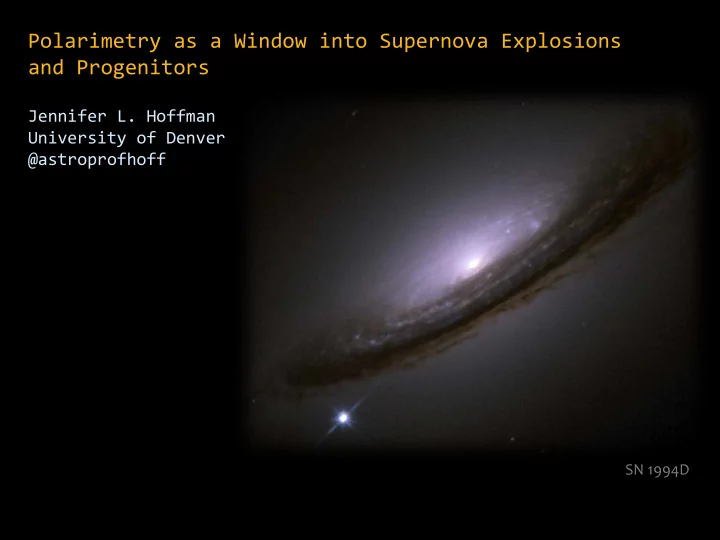

Polarimetry as a Window into Supernova Explosions and Progenitors Jennifer L. Hoffman University of Denver @astroprofhoff SN 1994D
Why do we care about supernova polarization? (Linear) polarization results from asphericity, so… • It yields insight into collapse/explosion mechanisms. • It tells us about the stellar winds and circumstellar material of progenitor stars. • It helps us probe stellar evolution in faraway galaxies. • It has potential implications for the use of some supernovae as cosmological probes. SN 2008aq
All types of supernovae can be polarized! < 10 M
Very hot ejecta ⇒ electron scattering is the polarizing mechanism. Leonard+ 2007
A polarized SN continuum indicates aspherical ejecta. SN 2004dj (II-P) Leonard+ 2006
Polarization in spectral lines probes distribution of elements in the ejecta and surroundings. SN 2001el (Ia) Kasen+ 2003
Next frontier in SN studies : time-domain spectropolarimetry! SN 1997eg (IIn) H α Rel. Flux Pol. (%) PA (º) Wavelength (Å) Hoffman+ 2008
Next frontier in SN studies : time-domain spectropolarimetry! SN 1997eg (IIn) Hoffman+ 2008
Next frontier in SN studies : time-domain spectropolarimetry! SN 1997eg (IIn) Hoffman+ 2008
Next frontier in SN studies : time-domain spectropolarimetry! SN 1997eg (IIn) Hoffman+ 2008
Next frontier in SN studies : time-domain spectropolarimetry! SN 1997eg (IIn) Hoffman+ 2008 With this technique, we can probe pre-existing CSM and infer progenitor properties.
The SNSPOL project (led by U. Arizona) is creating the largest database of supernova polarization evolution to date. 6.5-m MMT, Mt. Hopkins DU grad student Leah Huk @MMT 2.3-m Bok, Kitt Peak 61” Kuiper, Mt. Bigelow
50+ SNe of all types observed so far, most at multiple epochs. Ia II IIn IIb II-L SN 2011 fe (16) SN 2011bv (2) SN 2009ip (12) SN 2011dh (4) SN 2014G (8) SN 2012cg (11) SN 2013am (12) SN 2010jl (30) SN 2012fg (12) SN 2012ht (3) SN 2013bu (9) SN 2011cc (1) SN 2013ak (5) SN 2013fw (1) SN 2013ee (5) SN 2011ht (7) SN 2013df (4) SN 2014ao (4) SN 2013hj (3) PTF11iqb (1) ASASSN-14az (5) SN 2014J (7) SN 2012ab (2) SN 2014ab (17) Ib II-P SN 2012 au (19) SN 2012A (22) iPTF13bvn (3) SN 2012aw (24) SN 2012ch (2) SH 2012ec (20) Ic SH 2012ho (1) PTF12gzk (5) SN 2013ab (12) SN 2012ej (8) SN 2013bi (11) SN 2012fh (16) SN 2013ej (11) SN 2013ff (7) SN 2013fs (9) SN 2013ge (8) SN 2014A (3) SN 2014as (2) SN 2014bc (1) SN 2014ad (7) SN 2014L (10)
SN 2009ip: Multiple maxima over several years suggest pre-explosion LBV eruptions. What caused the two 2012 peaks? 2012b 2012b V abs =-18 V abs =-18 2012a 2012a V abs =-14.5 V abs =-14.5 Mauerhan+ 2013
The two 2012 maxima showed orthogonal polarization angles, implying they were not due to successive shell ejections. SN 2009ip, V band High %P at 2012b is typical of CSM interaction. Mauerhan+ 2014
The picture from spectropolarimetry: ejecta asphericity plus interaction with pre-existing equatorial CSM. Mauerhan+ 2014 Torus geometry is often seen around LBVs, B[e] supergiants, etc.
What’s next for polarized supernovae? • Better statistics: more objects, greater wavelength and time coverage • Modeling: individual objects, object classes, time evolution • Classification: illuminate relationships among subtypes • Late stellar evolution: draw connections with potential progenitors • GMT polarimetry not ruled out, but needs community push! (Want to help?) SN 2004dj
What’s next for polarized supernovae? Robert Stobie N II H I N III Bowen Intensity (arb units) O III Bowen Spectrograph (RSS) at SALT 1.8 (11-m): 1.0 Polarimetry commissioning 0.2 will start in Pol (%) 1.5 2015. 1.0 0.5 ← T Pyx 2011 Position Angle (deg) 0.0 nova outburst, 110 R ~ 800. 100 90 3000 3500 4000 4500 5000 5500 6000 6500 Wavelength (Ang) Nordsieck 2012
Polarimetry as a Window into Supernova Explosions and Progenitors Jennifer L. Hoffman University of Denver @astroprofhoff SNSPOL: RSS: G. Grant Williams (MMTO) Kenneth H. Nordsieck (U. Wisconsin) Chris Bilinski (Steward Obs) Marsha Wolf (U. Wisconsin) Luc Dessart (U. de Nice) Jeff W. Percival (U. Wisconsin) Douglas C. Leonard (SDSU) Kurt P. Jaehnig (U. Wisconsin) Jon Mauerhan (UC Berkeley) Michael P. Smith (U. Wisconsin) Peter A. Milne (Steward Obs) Nathan Smith (Steward Obs.) Paul S. Smith (Steward Obs.) NSF AST-1210599 SN 1994D
Recommend
More recommend